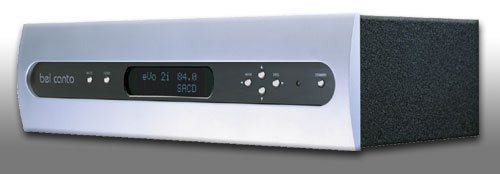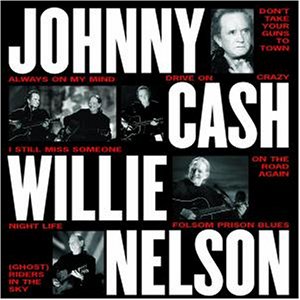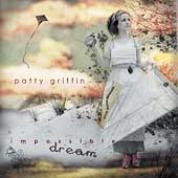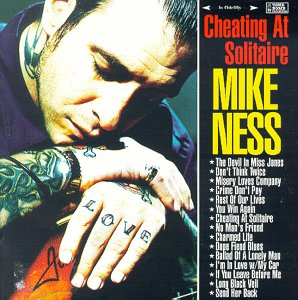Bel Canto eVo2i Gen II Integrated Amplifier
| Bel Canto eVo2i Gen II Integrated Amplifier |
|
The Brave New World? |
|
Eujin Hong |
|
November 2004 |

The Short Version
I have a confession to make: I’ve done you, our faithful readers, a bit of a disservice. You see, I really should have come right out with a review that gave the Bel Canto eVo2i Gen II a big thumbs-up long ago. But I held back, trying to find something about this integrated amplifier I disliked. After all, the last thing anyone needs is yet another rave review of a component that has garnered nothing but near-universal praise since its introduction.
So here’s the short version for those who don’t want to read through the various qualifications and validations that we reviewers tend to meander through before giving our final recommendation: Find a Bel Canto dealer and audition the eVo2i Gen II. If you’re in the market for an integrated in the sub-$4,000 category, nay, even if you want to spend more than that, you really must put the eVo2i Gen II on your shortlist. For those of you who currently own the original eVo2i, the Gen II carries a number of improvements, chief among which are enhancements to the amplifier board and a preamp board with technology derived from the Bel Canto Pre6. As of this writing, Bel Canto is offering an upgrade program for owners who wish to have their units updated to Gen II levels (see Bel Canto’s Web site for details.)
Staking a Claim
OK, now that my little confession is out of the way, let’s get back to basics. First, a quick little bit of history. The original eVo2i was a digital integrated amplifier based on Bel Canto’s eVo amplifier technology. According to Bel Canto’s Web site, their digital amplification combines, “the musicality of the old tube architectures with the power and drive of the best solid-state amplifiers, the eVo architecture achieves efficiency and performance levels which eclipse the best of either old world view.” That’s quite a claim to put out there, especially since it runs the risk of alienating lovers of tubed amplification and fans of solid-state design.
Ultimately, whether or not you subscribe to Bel Canto’s worldview depends on two crucial, often polarizing issues: how one defines “musicality” and what it means to “eclipse” a technology. I’ll tell you right now that I think “musicality” is a personal and, therefore, subjective yardstick by which to measure any component. Similarly, my personal jury is still out on the “eclipse” issue. But I will tell you this—the eVo2i Gen II is like no amplifier (tubed or solid-state) that I’ve ever heard.
Ones & Zeros
It seems like the whole world’s gone digital. In the modern consumer marketplace, I can scarcely think of any product that doesn’t have the word “digital” in its marketing copy—TVs, toasters, even the tire-pressure monitor I keep in the trunk of my car. Crazy. But that old “D” word comes with a whole lot of baggage for audiophiles. It seems only yesterday that the red book CD format was launched with the attendant fanfare and hype that promised “perfect sound forever.” Whatever.
We all know the negative stereotypes that accompany “digital” technology in audiophile equipment, that such components must sound brittle, or thin or bright. Well, I can tell you right now that none of these adjectives apply to the Bel Canto eVo2i Gen II. Right out of the box, the Gen II made me sit up and listen. I don’t really know what I expected digital amplification to sound like, but the music coming out of my speakers, didn’t sound like it was coming out of my speakers.
Let me explain.
It’s a bit difficult to imagine or to grasp unless you’ve heard it yourself. Indeed, before the Gen II showed up in my system, I’d never really heard anything like what I’m about to describe. When music started to play through the Gen II, sounds seemed to materialize out of thin air in front of me. Part of this effect has something to do with the Gen II’s awesome pinpoint imaging ability. But that’s just not doing it justice. The best way I can put it is that the music I heard never seemed tethered to my speakers; the sounds just seemed to emerge in front of my eyes and ears.
What does silk sound like?
In the time that the eVo2i Gen II was in my system, I found myself listening to a lot of “Live” recordings. I think this might have something to do with the phenomenon I’ve just described. Good recordings of live performances just seemed more compelling and more enjoyable with the Bel Canto.  I started with VH1 Storytellers: Johnny Cash/Willie Nelson [American B000068FWG], a disc that had had been recommended to me by Bel Canto honcho, John Stronczer. This is a live recording of the two legends, with two stools and two guitars. It’s a fabulous disc that I treasure—even more so now that the great Johnny Cash is no longer with us. The opening track, Ghost Riders in the Sky, is a great song and immediately showed me what the Gen II is capable of. One of the more interesting aspects of good live recordings is the fact that they sound more spontaneous and alive than any studio album can ever be. And so it is with Storytellers. The thing that immediately struck me about the Ghost Riders track was that Johnny Cash’s voice seemed to be emanating from a point higher up than Willie Nelson’s. With most recordings, you can easily identify the performer on the left and the performer on the right—that’s a no-brainer when it comes to duets. And with many studio duets, both performers seem to sound like they’re the exact same height, even if they aren’t in real life. The disparity between the relative heights of Cash’s and Nelson’s voices struck me immediately. When I consulted the insert that accompanied the CD, I found out exactly why. One of the photos in the insert shows the two performers on stage—Johnny Cash’s microphone is aimed a lot higher up than Willie Nelson’s! Very cool. I hadn’t noticed this the many previous times I’d listened to his album on my Coda-Continuum Unison integrated amplifier. But when I switched back to the Coda, I was now able to hear this, but it was only because I now knew what to listen for.
I started with VH1 Storytellers: Johnny Cash/Willie Nelson [American B000068FWG], a disc that had had been recommended to me by Bel Canto honcho, John Stronczer. This is a live recording of the two legends, with two stools and two guitars. It’s a fabulous disc that I treasure—even more so now that the great Johnny Cash is no longer with us. The opening track, Ghost Riders in the Sky, is a great song and immediately showed me what the Gen II is capable of. One of the more interesting aspects of good live recordings is the fact that they sound more spontaneous and alive than any studio album can ever be. And so it is with Storytellers. The thing that immediately struck me about the Ghost Riders track was that Johnny Cash’s voice seemed to be emanating from a point higher up than Willie Nelson’s. With most recordings, you can easily identify the performer on the left and the performer on the right—that’s a no-brainer when it comes to duets. And with many studio duets, both performers seem to sound like they’re the exact same height, even if they aren’t in real life. The disparity between the relative heights of Cash’s and Nelson’s voices struck me immediately. When I consulted the insert that accompanied the CD, I found out exactly why. One of the photos in the insert shows the two performers on stage—Johnny Cash’s microphone is aimed a lot higher up than Willie Nelson’s! Very cool. I hadn’t noticed this the many previous times I’d listened to his album on my Coda-Continuum Unison integrated amplifier. But when I switched back to the Coda, I was now able to hear this, but it was only because I now knew what to listen for.
So, right from the get-go, I immediately formed the impression that the Gen II was capable of quite amazing feats of imaging and soundstaging (both in terms of height and depth). Over time, and many different albums, my respect and fascination for this amp and its digital technology only grew.
But nothing can make a silk purse out of a sow’s ear.
 Not even an amplifier with the silken qualities of the eVo2i Gen II. One of my favorite recent music purchases has been Impossible Dream [ATO0017] by Patty Griffin. The songs on this album are consistently good to great. And all of them hinge on the emotive lyrics penned by Ms. Griffin and her evocative vocals. Unfortunately, the first track, “Love Throw Me a Line“ is miserably recorded—muffled, muddy sounding and generally poor. It’s especially odd because the rest of the album is very nicely recorded. Still, it goes to show that the principle of “garbage in, garbage out” continues to hold true with the Bel Canto—you’ll get fabulous sounds out of this amp if the source material is up to par, but don’t expect the transmogrification of poor recordings.
Not even an amplifier with the silken qualities of the eVo2i Gen II. One of my favorite recent music purchases has been Impossible Dream [ATO0017] by Patty Griffin. The songs on this album are consistently good to great. And all of them hinge on the emotive lyrics penned by Ms. Griffin and her evocative vocals. Unfortunately, the first track, “Love Throw Me a Line“ is miserably recorded—muffled, muddy sounding and generally poor. It’s especially odd because the rest of the album is very nicely recorded. Still, it goes to show that the principle of “garbage in, garbage out” continues to hold true with the Bel Canto—you’ll get fabulous sounds out of this amp if the source material is up to par, but don’t expect the transmogrification of poor recordings.
Elsewhere on Impossible Dream, Ms. Griffin’s voice and guitar work are beautifully conveyed through the Bel Canto. There is no hint of stridency in the higher registers or break-up. More importantly, the Bel Canto seems to preserve the same quality in music throughout the frequency range, without the sound turning hard or opaque in the highs. Vocals tend reap the greatest benefit. Track 6, “Top of the World“ really shows off the eVo2i Gen II in this regard. The song begins with Ms. Griffin at the lower end of her range, where her voice comes across in an intimate, breathy tone, before opening up and soaring in the midrange and upper midrange. Some tracks, like Track 8’s When it don’t come easy, are anchored by pianowork that lays down an underlying foundation that lends the song a sense of gravity. On this track, the eVo2i Gen II successfully manages to impart a realistic-sounding piano without taking away from the presence of Ms. Griffin’s vocals. In fact, this is one of the more complex tracks on this album, with the piano, bass, drums, a trumpet and backing vocals thrown into the mix. Even so, the eVo2i never sounds flustered and the music is pleasantly layered, not congested or confused.
A Different Animal
The last couple of years have seen a real resurgence of interest in tubed amplification. As a former manufacturer of tubed components, it would have been all too easy for Bel Canto to hype their new digital amplification technology as “tube-like” in sound. But instead, Bel Canto has embraced this digital technology and discarded the tube crutch. Bravo, I say. And brave. Still, there are some sonic qualities that the eVo2i Gen II shares with tubed amplification. First among these qualities is the sheer presence that the Gen II imparts on the music. Remember that almost-eerie materialization of music I mentioned earlier in this review? Well, tubes sometimes make me feel like that. In this respect, the eVo2i Gen II sounds like a tube on steroids.
This presence meshes extremely well with the liquid-smooth presentation of the amplifier, creating a seamless sense of real music being performed by real artists. But can an amplifier sound too smooth?! I wondered about this and decided to put in an old favorite that I haven’t listed to in a while: Cheating at Solitaire [Time Bomb 43524] by former Social Distortion front man Mike Ness.  This album is a rocking combination of bluegrass, punk, country and whatever else Ness has decided to throw together. Would the eVo2i Gen Ii be able to recreate Ness’s snarling vocals and raucous instrumentation? The answer is a qualified yes. All the driving rhythm and slam that I remember from this album is there—and then some. And Mike Ness sounds like the same brash, bold, rabble-rouser that I’ve become familiar with over the years. But the eVo2i Gen II offers a slightly different take on raw, powerful music. Think sushi versus a steak done rare—it’s all in the texture and taste. Some of you won’t care one whit, while others might find the eVo2i Gen II either too much or too little.
This album is a rocking combination of bluegrass, punk, country and whatever else Ness has decided to throw together. Would the eVo2i Gen Ii be able to recreate Ness’s snarling vocals and raucous instrumentation? The answer is a qualified yes. All the driving rhythm and slam that I remember from this album is there—and then some. And Mike Ness sounds like the same brash, bold, rabble-rouser that I’ve become familiar with over the years. But the eVo2i Gen II offers a slightly different take on raw, powerful music. Think sushi versus a steak done rare—it’s all in the texture and taste. Some of you won’t care one whit, while others might find the eVo2i Gen II either too much or too little.
Comparisons & Conclusions
This is normally the part in the review where I like to compare the review component against other competitors in its class. Well, I’m not quite sure what to do this time, because I haven’t heard any other digital amplifiers and the eVo2i Gen II just doesn’t fit into the comfortable, preconceived categories of equipment that we’ve created for ourselves. For what it’s worth, I can verify that the Bel Canto eVo2i does indeed deliver the presence, smoothness and lifelike quality of a tubed amplifier, while retaining the control, drive and efficiency of solid-state designs. Music seems to flow from this amplifier. I’d like to draw on the analogy I used when I reviewed the Krell KAV-400xi a while back, where I compared that amp to a world-class sport sedan…but I can’t. Because the eVo2i Gen II just seems to glide so effortlessly over all kinds of music, from fragile, sparse acoustic pieces, to complex, multi-layered sonic puzzles. This amp flushes out hidden little details and fleshes them out for this listener. For these qualities alone, I would give the eVo2i Gen II my unreserved recommendation. But Bel Canto has thrown in a bunch of other bells and whistles to sweeten the deal. For starters, the eVo2i Gen II gives you a remarkable degree of control over the possible settings of the amp. You can rename inputs, disable them or enable them at will (except the TAPE input) and each input will also retain an independent volume setting. Very nifty stuff. But speaking of volume settings, be advised that out of the box, the volume is maxed out, so be sure to turn the volume setting down before you press that “PLAY” button—a blown speaker or ear drum won’t be a good way to kick-off your introduction to Bel Canto!
For those of you who don’t care for the extras that Bel Canto have built into the eVo2i Gen II, just sit back and enjoy the music. And with this amp, you really will be busy enjoying said music. My one regret is that there aren’t more Bel Canto dealers out there. If, like me, you live in a state without an authorized Bel Canto dealer, I urge you to call the company and make arrangements with them to audition an eVo2i Gen II—I should know, because I wish I’d done the same a long time ago.
_____________
Specifications:
Power Output Per Channel: 120 watts @ 8 Ohms, 200 watts @4 Ohms
Frequency Response: 1Hz to 80 kHz –3dB
THD: < 0.05% at 1 WRMS
Gain: 16dB preamp section, 23 dB amp section
Input impedance: 10k/20k Bal
Idle Power Draw: 20 W
Inputs: 1 pair balanced (XLR), 4 pairs single-ended RCA
Outputs: 1 Pair 5-Way Binding post/channel, 1 Tape Out, 1 Line Out
Dimensions: 17.5 (w) x 4.5 (h) x 14.5 (d) in.
Weight: 36.0 lb/16 kg
Price: $3,000
Company Information
Bel Canto Design
212 3rd Avenue North
Minneapolis, MN 55401, USA
Tel: 612-317-4550 (9AM CST to 5 PM CST M-F)
Toll-free (866) 200-7342
Fax: 612-359-9358
Website: www.belcantodesign.com
![]()
Don’t forget to bookmark us! (CTRL-SHFT-D)
Stereo Times Masthead
Publisher/Founder
Clement Perry
Editor
Dave Thomas
Senior Editors
Frank Alles, Mike Girardi, Russell Lichter, Terry London, Moreno Mitchell, Paul Szabady, Bill Wells, Mike Wright, and Stephen Yan,
Current Contributors
David Abramson, Tim Barrall, Dave Allison, Ron Cook, Lewis Dardick, John Hoffman, Dan Secula, Don Shaulis, Greg Simmons, Eric Teh, Greg Voth, Richard Willie, Ed Van Winkle, Rob Dockery, Richard Doran, and Daveed Turek
Site Management Clement Perry
Ad Designer: Martin Perry





Be the first to comment on: Bel Canto eVo2i Gen II Integrated Amplifier